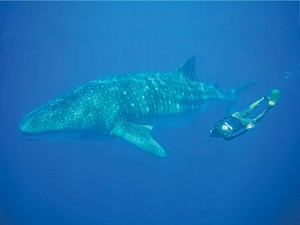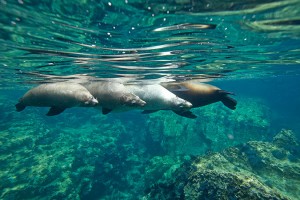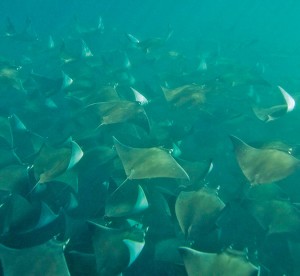A look at the rich sea life that abounds in the Sea of Cortés
By Beto Haro Romero

Los Cabos has plenty to offer by land, but it’s the vibrant underwater world that surrounds the Baja Peninsula that makes it an extraordinary destination.
The Pericúes—the original inhabitants of Southern Baja—would refer to what is now Cabo San Lucas as Yenecamú, “a place between two waters” because it has the Pacific Ocean on one side and the Sea of Cortés on the other. And acclaimed explorer Jacques Cousteau called the Sea of Cortés “the aquarium of the world” due to its large concentration of sea creatures ranging from tiny fish to the largest of them all, the whale shark; as well as five of the world’s seven types of sea turtles; and several types of whales.
The ways in which you can admire these creatures are almost as plentiful as the animals themselves: See them while snorkeling, diving, whale watching, and more. There are several companies dedicated to such activities, including Cabo Expeditions (www.caboexpeditions.com.mx), Pez Gato (www.pezgato.com), and Cabo Sails (www.cabosails.com).
There are many locations to snorkel or dive. See more than 50 kinds of tropical and subtropical fish at Pelican’s Rock near Lover’s Beach. Within five to 25 feet of the surface, there are parrotfish, sergeant major, angelfish, blowfish, triggerfish, large schools of sardines, coral, and gorgonians. Diving allows you to see smaller creatures that like to hide in crevasses. There are lobsters; zebra, spotted, and big green moray eels; bonitas; and snappers. You can also check out the famous sand falls, while diving 80 to 120 feet. The continual runoff of sand into the sea’s abyss is mesmerizing.
Tourist favorites Santa María Cove and Chileno Bay are two more nearby options. Both are public beaches located off the Tourist Corridor, between Cabo San Lucas and San José del Cabo. Reach them by car and take off from the beach or arrive via boat in order to explore the coral and sea life in protected, shallow waters.
Discover a seamount in Gordo Banks, roughly 10 miles from Puerto Los Cabos. Expect to see groupers, jacks, snappers, mackerels, as well as the occasional tuna, different types of rays, and maybe even a school of hammerhead sharks. The top of the seamount is around 125 feet below the surface and covered in black coral.


Famous Cabo Pulmo, some 60 miles from Cabo San Lucas, is home to the only living reef in the North American Pacific. Of the area, John Steinbeck once wrote: “Clinging to the coral, growing on it, burrowing into it, was a teeming fauna … One small piece of coral might conceal 30 or 40 species, and the colors on the reef were electric.” Snorkel from the beach to the shallow coral reef or dive 30 to 65 feet to see giant manta rays, huge schools of jack, and other great fish.
Several local outfits arrange tours to La Paz, two hours north of Cabo. Come here to swim with whale sharks, the gentle giants of the oceans. They can be found in the Bay of La Paz, just a short ride from the capital city’s beautiful boardwalk. Though only juveniles, they are enormous, measuring 10 to 30 feet. They are filter feeders and eat only tiny food, so don’t be afraid to jump in and swim alongside them.
Also off the coast of La Paz is the 60-square-mile Espíritu Santo Archipelago, which includes Espíritu Santo Island—known as the jewel of the Sea of Cortés. The sightseeing at this UNESCO World Heritage site is amazing, and its coves and bays are rightfully known as some of the most beautiful in the world. Snorkel with hundreds of sea lions, some so playful that they’ll approach you. Or head to El Corralito, a cove protected from the wind, to explore coral and a variety of fish in shallow, flat water.
The Sea of Cortés is known as one of the world’s best destinations for whale watching. During winter and early spring, you can watch migrating whales, including grays, humpbacks, fin, blue, sperm, pilot, and killer whales.
Whatever you do, bring your underwater camera and a sense of adventure. You won’t regret it.



